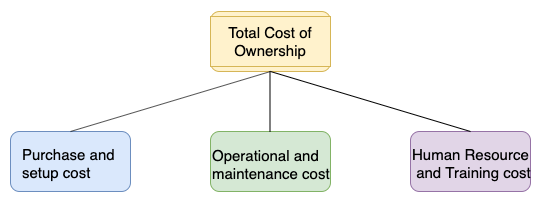Often, organizations tend to overlook the total cost of ownership (TCO) and take decisions based on the upfront cost to acquire software and services, known as capital expenditure (CapEx). While the upfront cost determination is essential, in the long run, the TCO matters the most. The TCO includes both CapEx and operational expenditure (OpEx), covering all the dimensions of the application life cycle. The CapEx cost includes the price organizations pay upfront to acquire services and software, while OpEx includes the cost of operation, maintenance, training, and retirement of software application. You should consider all associated costs to help to make more strategic decisions while calculating your ROI in the long run.
For example, when you buy a refrigerator, which is going to run 24/7, you look for an energy-saving rating to keep your electricity bill low. You are ready to pay a higher price upfront as you know the total cost over time will be low due to the saving in the energy bill.
Now let's take an example of a data center. There is an upfront hardware acquisition cost involved, the CapEx. However, the data center setup requires additional ongoing costs, the OpEx, which includes heating, cooling, rack maintenance, infrastructure administration, security, and so on.
For a typical use case, when you are purchasing and implementing software, consider the following costs to calculate the TCO:

Let's look at this at a more granular level. Each TCO component has the following common costs involved for off-the-shelf software such as Oracle or MS SQL database:
- Purchase and setup costs: These are the upfront cost to acquiring the software and the services to deploy software. This includes the following:
- Software price includes software with user licenses
- Hardware cost includes purchasing a server and storage to deploy software
- Implantation cost includes the time and effort to get it ready for production
- Migration cost includes moving data to the new system
- Operational and maintenance costs: This continues the cost of service to keep the software running for the business use case. This cost includes the following:
- Software maintenance and support
- Patching and update
- Enhancement
- Data center cost to maintain hardware server
- Security
- Human resources and training costs: This is the overhead cost to train staff so that they can use the software to address business activities. This cost includes the following:
- Application admin staff
- IT support staff
- Functional and technical consultant
- Training cost and training tools
When looking for a solution, you will have multiple choices (such as taking out a subscription for a software as a service (SaaS) product such as Salesforce CRM). The SaaS model is mostly subscription-based, so you need to determine whether you are getting the desired ROI for a more significant number of uses. You can take a hybrid approach and use the cloud to handle your hardware by choosing the Infrastructure as a Service (IaaS) option and installing off-the-shelf software. Overall, if the available software doesn't meet your requirements, you can choose to build it by yourself. In any scenario, you should calculate the TCO to make a decision where you can make the maximum ROI. Let's look at budget and forecast planning, which can help to control TCO and achieve ROI.
